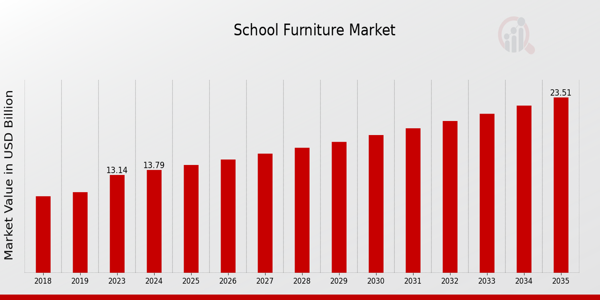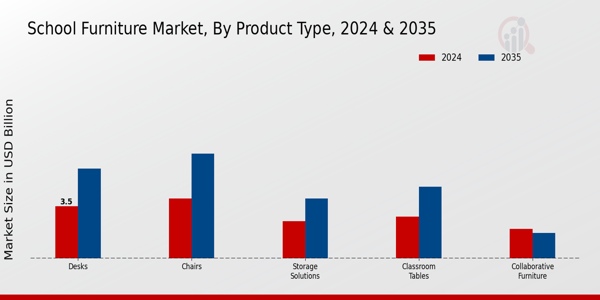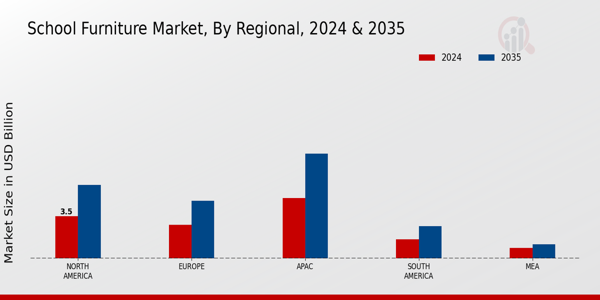Global School Furniture Market Overview
As per MRFR analysis, the School Furniture Market Size was estimated at 13.14 (USD Billion) in 2023.
The School Furniture Market is expected to grow from 13.79 (USD Billion) in 2024 to 23.5 (USD Billion) by 2035. The School Furniture Market CAGR (growth rate) is expected to be around 4.97% during the forecast period (2025 - 2035).
Key School Furniture Market Trends Highlighted
A number of significant market factors are influencing the growth of the global school furniture industry. Educational institutions are being pushed to invest in contemporary and ergonomic furniture designs by the growing emphasis on creating settings that are conducive to learning.
Furthermore, there is a greater understanding of how furniture affects students' performance and well-being on a physical and psychological level.
Because of this understanding, schools are encouraged to use furniture that fosters active learning and collaboration in addition to being comfortable. The necessity for flexible furniture that can support a range of classroom devices has been sparked by the continuous trend toward digitization in education.
The growing demand for eco-friendly and sustainable products indicates market opportunities. Manufacturers have the opportunity to develop and provide sustainable furniture solutions as educational institutions grow more ecologically concerned. An important possibility is also presented by furniture designs that are flexible and adaptive to dynamic learning environments.
Moreover, the homeschooling trend has led to a surge in demand for furniture that is suitable for various learning environments, thus opening avenues for product diversification. Trends in recent times also reflect a greater focus on multifunctional furniture that can be easily rearranged to suit different teaching methods.
Height-adjustable desks and collaborative seating arrangements are becoming more prevalent, catering to diverse learning styles. There is also a growing trend towards customizability, allowing schools to tailor furniture solutions to their unique needs.
As schools seek to enhance student engagement and collaboration, the School Furniture Market will likely continue to evolve, adapting to the changing educational landscape while addressing the growing demand for innovative and sustainable solutions.

School Furniture Market Drivers
Growing Educational Institutions and Infrastructure Development
The expansion of educational institutions across the globe is a primary driver for the School Furniture Market. As countries and regions work towards improving their educational systems, there is a significant increase in the number of schools being established.
This trend is especially prominent in developing nations where educational infrastructure is being prioritized to ensure that children have access to quality education. The construction of new schools requires a large quantity of furniture, including desks, chairs, tables, and specialized furniture designed for different age groups and educational purposes.
As awareness of the importance of ergonomically designed furniture grows, schools are increasingly investing in quality furniture that promotes better learning environments.
Furthermore, existing institutions are also upgrading their facilities to create modern classrooms that support interactive learning, which requires additional furniture resources. This constant development and renewal of educational infrastructure drive sustained demand for furniture, contributing significantly to the market's growth.
In addition, government initiatives aimed at enhancing the educational landscape thus further spurs investments in school furniture, indicating that the School Furniture Market is set for steady growth going forward.
Increasing Focus on Ergonomics and Comfort in Learning
The School Furniture Market is experiencing a shift toward the adoption of ergonomic and comfortable furniture solutions. Educational institutions are recognizing the importance of providing students with furniture that supports healthy posture and comfort during long hours of study.
As more research highlights the correlation between student comfort and academic performance, schools are prioritizing investments in ergonomic furniture that minimizes physical strain and distraction.
This trend is not only beneficial for students' physical well-being but also for their cognitive development, thereby enhancing the learning experience. Consequently, manufacturers are innovating their designs to create furniture that combines aesthetics with ergonomics, further driving the market's evolution.
Rise in Technological Integration in Education
The digital revolution in education, characterized by the integration of technology into the learning environment, is a crucial driver for the School Furniture Market.
Classrooms are evolving into tech-enabled spaces that require furniture to accommodate digital tools such as computers, tablets, and interactive whiteboards. This transformation necessitates furniture solutions that provide flexibility, such as modular desks and collaborative seating arrangements.
As schools adopt a more technology-centric approach to education, the demand for specialized furniture that supports the use of these tools is increasing. Additionally, this integration facilitates various learning methodologies, such as group work and individualized instruction, calling for innovative furniture designs that can easily adapt to different teaching styles.
School Furniture Market Segment Insights
School Furniture Market Product Type Insights
The School Furniture Market exhibited a diverse range of product types that catered to various educational environments, showcasing a significant valuation structure.
The segment of desks held a valuation of 3.5 USD Billion in 2024, reflecting its vital role in the classroom setting, as they were essential for student learning and activities. Chairs also played a significant role, valued at 4.0 USD Billion in 2024, representing a majority holding in the market due to their necessity for comfort and ergonomics in learning spaces.
Storage solutions were valued at 2.5 USD Billion, serving a critical function in organizing educational materials and resources vital for effective teaching and learning experiences. Classroom tables were projected at a valuation of 2.8 USD Billion, underscoring their importance in facilitating group work and collaborative activities among students.
Collaborative furniture, while innovative, was valued at 1.99 USD Billion in 2024, indicating a growing trend towards flexible learning environments, though it held a smaller market share when compared to more traditional furniture such as chairs and desks.
The School Furniture Market segmentation clearly illustrated that while all categories were essential, chairs and desks dominated due to their primary role in daily student interactions. Each product type significantly contributed to the overall market growth, driven by evolving educational methodologies and a focus on enhancing student engagement and comfort.
The insights reflected ongoing trends toward modernizing classrooms, necessitating investments in diverse furniture types to support varied learning styles and collaborative education.

School Furniture Market Material Insights
The School Furniture Market showcases a diverse range of materials pivotal to its growth. Wood remains a trusted choice, valued for its durability and aesthetics, contributing significantly to the market revenue while offering a classic touch to school environments.
Metal is also essential; it provides long-lasting strength, making it popular in diverse applications like desks and chairs. Plastic is gaining traction due to its lightweight nature and easy maintenance, appealing to budget-conscious educational institutions.
Composite materials combine the benefits of wood and plastic, offering durability and aesthetic appeal, while fabric plays a crucial role in enhancing comfort for students. The School Furniture Market segmentation reflects these varying material preferences, indicating that the industry is responding to changing educational needs, sustainability concerns, and budget constraints.
Market growth is further fueled by the increasing investments in educational infrastructure and the rising focus on creating conducive learning environments. However, challenges such as fluctuating raw material prices and environmental regulations pose risks to market players.
Opportunities exist in innovation and customization to meet specific educational requirements. Overall, the material segment holds a significant influence in shaping the School Furniture Market landscape.
School Furniture Market End User Insights
The segment is diversified into various end users, such as Primary Schools, Secondary Schools, Higher Education Institutions, and Vocational Training Centers. Among these, Primary Schools play a crucial role, catering to the foundational education of children, thereby driving demand for age-appropriate and ergonomic furniture. Secondary Schools follow closely, emphasizing modular and adaptable furniture solutions to accommodate evolving pedagogical methods.
Higher Education Institutions are increasingly investing in more sophisticated and functional furniture to create conducive learning environments, making them a significant contributor to market dynamics. Additionally, Vocational Training Centers are gaining attention as they require specific furniture tailored to hands-on training, further expanding the market's potential.
The landscape of the School Furniture Market reflects a steady growth trajectory, driven by rising enrollment rates and a shift towards enhanced classroom experiences, coupled with the challenge of meeting diverse needs for furniture customization across various educational settings.
In summary, the ongoing transformation in educational environments underscores the importance of these end user segments in shaping the future of the School Furniture Market statistics.
School Furniture Market Distribution Channel Insights
The School Furniture Market revenue showcases a diverse distribution channel segment that significantly influences the overall industry dynamics. This segment is expected to shape the purchasing landscape of educational institutions.
The growth of online retail has transformed the buying process, offering convenience and access to a wider inventory, which resonates particularly well with tech-savvy consumers. Meanwhile, offline retail remains a vital component, providing hands-on experience and personalized service that many educators prefer.
Direct sales continue to hold a significant portion of the market, delivering tailored solutions directly to schools and fostering robust relationships between manufacturers and educational institutions. Observing the School Furniture Market statistics, it is evident that these distribution channels present unique opportunities; online platforms cater to increased digital engagement, while traditional methods emphasize trust in local communities.
Additionally, the varying preferences of schools and educational authorities spur growth drivers, but challenges such as supply chain disruptions and changing educational needs remain pivotal in shaping market trends within these distribution channels.
The School Furniture Market segmentation reflects these dynamics as stakeholders navigate an evolving landscape, ultimately impacting the overall market growth.
School Furniture Market Regional Insights
The School Furniture Market showed significant regional diversification. North America, commanding a market share with a valuation of 3.5 USD Billion in 2024, is projected to grow to 6.1 USD Billion by 2035, reflecting its major influence in the educational furnishings sector.
Europe followed closely with a 2024 valuation of 2.8 USD Billion, expected to reach 4.8 USD Billion subsequently, benefiting from ongoing modernization initiatives in educational facilities. The APAC region led in market size, contributing 5.0 USD Billion in 2024 and is anticipated to expand to 8.7 USD Billion, largely driven by increasing student enrollment and investment in educational infrastructure.
South America, valued at 1.6 USD Billion in 2024, was positioned for growth, reaching 2.7 USD Billion as educational reforms gained momentum. Meanwhile, the MEA market, although smaller at 0.89 USD Billion, saw gradual improvements as demand for quality educational products rose.
The variations in the School Furniture Market revenue across these regions highlighted the complex dynamics influenced by local trends, government policies, and educational advancement efforts. This segmentation revealed where opportunities lie for market growth and innovation in providing suitable furniture solutions.

School Furniture Market Key Players and Competitive Insights
The School Furniture Market is characterized by a dynamic competitive landscape where innovation and sustainability are at the forefront of industry trends. With the increasing investment in education and an emphasis on creating conducive learning environments, the demand for ergonomic, flexible, and durable school furniture has surged.
Manufacturers are increasingly focusing on adopting advanced materials and design concepts that enhance the learning experience, align with modern educational practices, and promote collaboration among students.
The market is influenced by various factors, including governmental policies, urbanization trends, and evolving educational methodologies. As educational institutions prioritize the integration of technology in classrooms, the furniture market is adapting by incorporating tech-friendly designs, thus increasing competition among key players.
K SA has established a strong presence within the School Furniture Market by focusing on quality and customization that meet diverse educational needs. With a reputation for creating innovative and multifunctional furniture solutions, K SA leverages advanced manufacturing techniques and high-quality materials to deliver products that promote comfortable and interactive learning experiences.
The company is recognized for its ability to respond quickly to market demands, ensuring that educational institutions receive tailored solutions that align with their specific requirements. Furthermore, K SA emphasizes sustainability in its product design and development processes, catering to the growing demand for eco-friendly options in the school furniture segment. This strategic approach positions K SA as a formidable competitor, enhancing its market share and brand recognition.
Herman Miller is well-regarded in the School Furniture Market, primarily due to its commitment to ergonomic design and functionality. The company integrates research and knowledge of educational environments to create furniture that fosters effective learning conditions. Herman Miller's product lines are designed with flexibility in mind, allowing schools to adapt their layouts to various teaching styles and classroom activities.
The emphasis on collaboration is evident in the innovative designs that promote group work and interactive learning experiences. Moreover, Herman Miller's strong focus on sustainability resonates with educational institutions seeking environmentally responsible products, further enhancing its market appeal.
The brand's legacy of quality and design excellence solidifies its reputation as a leader in the school furniture industry, making it a preferred choice among educational establishments looking to invest in high-quality, durable furniture solutions that meet contemporary learning demands.
Key Companies in the School Furniture Market Include
- K SA
- Herman Miller
- Virco
- Scholare
- ArtcoBell
- Steelcase
- Smith System
- KI
- VS America
- Community Products
- Bretford
- School Outfitters
- TECA
- Haworth
- Modern Classroom
School Furniture Market Developments
Recent developments in the School Furniture Market have highlighted a growing demand for innovative and adaptable furniture solutions to accommodate modern educational environments. Companies like Herman Miller and Steelcase are actively responding to trends such as flexible learning spaces and ergonomic designs, leading to an increase in their market valuations.
Virco and KI have also been enhancing their product offerings, focusing on collaborative and multifunctional furniture to meet the needs of contemporary classrooms. In terms of mergers and acquisitions, discussions around strategic partnerships have surfaced, particularly among players like Bretford and ArtcoBell, aiming to expand their market footprint and diversify their product lines.
The continued rise of e-learning and blended educational models has amplified the need for versatile furniture solutions, influencing growth strategies across the market. Additionally, with increased government funding towards education infrastructure, companies like Smith System and Modern Classroom are positioned to benefit, as investments in school facilities are likely to spur demand for quality, durable furniture.
Overall, the ongoing evolution in educational practices is shaping the direction of the School Furniture Market, prompting key players to adapt proactively.
-
School Furniture Market Segmentation Insights
-
School Furniture Market Product Type Outlook
- Desks
- Chairs
- Storage Solutions
- Classroom Tables
- Collaborative Furniture
-
School Furniture Market Material Outlook
- Wood
- Metal
- Plastic
- Composite
- Fabric
-
School Furniture Market End User Outlook
- Primary Schools
- Secondary Schools
- Higher Education Institutions
- Vocational Training Centers
-
School Furniture Market Distribution Channel Outlook
- Online Retail
- Offline Retail
- Direct Sales
-
School Furniture Market Regional Outlook
-
North America
-
Europe
-
South America
-
Asia Pacific
-
Middle East and Africa
| Report Attribute/Metric |
Details |
| Market Size 2023 |
13.14(USD Billion) |
| Market Size 2024 |
13.79(USD Billion) |
| Market Size 2035 |
23.5(USD Billion) |
| Compound Annual Growth Rate (CAGR) |
4.97% (2025 - 2035) |
| Report Coverage |
Revenue Forecast, Competitive Landscape, Growth Factors, and Trends |
| Base Year |
2024 |
| Market Forecast Period |
2025 - 2035 |
| Historical Data |
2019 - 2024 |
| Market Forecast Units |
USD Billion |
| Key Companies Profiled |
K SA, Herman Miller, Virco, Scholare, ArtcoBell, Steelcase, Smith System, KI, VS America, Community Products, Bretford, School Outfitters, TECA, Haworth, Modern Classroom |
| Segments Covered |
Product Type, Material, End User, Distribution Channel, Regional |
| Key Market Opportunities |
Increasing demand for ergonomic designs, Growth in online education furniture, Innovative eco-friendly materials, Enhancements in modular furniture solutions, Expansion in developing regions |
| Key Market Dynamics |
Growing educational infrastructure investment, Increasing focus on ergonomic designs, Rising demand for eco-friendly materials, Technology integration in furniture, Shift towards collaborative learning environments |
| Countries Covered |
North America, Europe, APAC, South America, MEA |
Frequently Asked Questions (FAQ) :
The School Furniture Market was valued at 13.79 USD Billion in 2024.
In 2035, the School Furniture Market is anticipated to reach a valuation of 23.5 USD Billion.
The expected CAGR for the School Furniture Market from 2025 to 2035 is 4.97%.
In 2024, the Asia-Pacific region held the largest market share, valued at 5.0 USD Billion.
The market size for desks within the School Furniture Market is projected to be 6.0 USD Billion in 2035.
Key players in the School Furniture Market include K SA, Herman Miller, Virco, and Steelcase.
The market for chairs in the School Furniture Market was valued at 4.0 USD Billion in 2024.
By 2035, the School Furniture Market in South America is projected to reach a market size of 2.7 USD Billion.
The School Furniture Market faces challenges related to product customization while presenting opportunities in sustainable materials.
The market size for storage solutions in the School Furniture Market is expected to be 4.0 USD Billion in 2035.

















